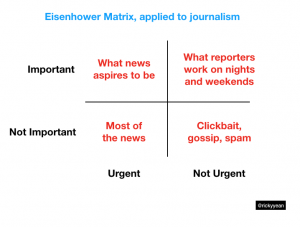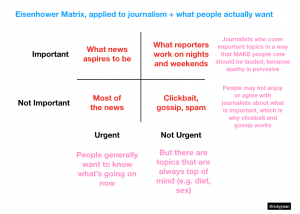If you are looking for media coverage, you’ve come to the right place. Successful PR is simple. Here are the steps.
- Generate interesting stories consistently.
- Pitch your stories to writers who create content for an audience you’re interested in.
- Analyze results, rinse and repeat.
 It’s a simple process to follow, like keeping the count when you’re dancing. 1–2–3, 1–2–3, 1–2–3. However, in our experience, this might not be what you’re thinking about when you think about PR. You’re racing to the desired outcome — the gleaming article on a top industry news site trumpeting the latest and greatest about your company. It feels attainable (and it is) because we all consume a ton of content every day.
It’s a simple process to follow, like keeping the count when you’re dancing. 1–2–3, 1–2–3, 1–2–3. However, in our experience, this might not be what you’re thinking about when you think about PR. You’re racing to the desired outcome — the gleaming article on a top industry news site trumpeting the latest and greatest about your company. It feels attainable (and it is) because we all consume a ton of content every day.
We read about companies, sometimes in our industry, having seemingly accomplished much less than us, yet they are receiving a glowing profile. Surely you can get the same treatment. PR doesn’t seem like it requires a process.
No one expects to make a sale on the first call, rank on Google after a few days of SEO, or publish a few posts to immediately find an audience for your blog, but most people think of PR as an easy transaction— I have a story, it’s the reporters’ job to write it. This is wrong. Yes, if you just raised $50M in venture funding from Bill Gates, you can send an email to any reporter at a business publication and the story will get written. Outside of must-cover stories like that, successful PR requires a process because what is worth covering is, at the end of the day, subjective.
Let’s break down three common misconceptions about PR compared to reality.
Customer misconception #1:
I have news (e.g. launch, a milestone reached, etc) that is really significant to us. With the right PR help, we can get someone to write about it.
How It Actually Works
Journalists are choosing from hundreds of stories to cover every day for maybe 1–3 slots. First, the sheer volume means that even if your story is perfectly targeted, they may simply miss it or lack the bandwidth to work on it. They are reading their inbox just like everyone else, without any more sophisticated triage processes. That’s assuming your story is a perfect A+.
In reality, most stories we pitch for companies are “B+” stories. They’re interesting, hard news, targeted at reporters who would have a personal or professional interest. However, there are almost always other “A” stories being pitched to the same reporters from other sources who may be bigger and more credible than you, and in the case where we are being evaluated against 50 other “B+” stories, it takes some luck to be selected.
We like to think of PR as closer to playing baseball. A good hitter in baseball succeeds only 30% of the time. The important part is approaching every at-bat with discipline and look for the rare opportunity to put the bat on the ball.
Customer Misconception #2
I just read a non-news story (e.g. a feature profile, a trend story about the industry, contributed opinion piece, etc) about my competitor. With the right PR help, we can get an article like that about me.
How It Actually Works
News takes precedence at most publications because they are urgent and sometimes important, yet many reporters spend time (often at nights and weekends) working on non-news stories because of personal interest and potential for impact. However, reporters still have to justify it to their editor, so pegging it to a hard news pitch is still preferred. For example, if your company just raised $200M and became a unicorn, you can pitch a personal profile at the same time so the reporter can better justify doing a profile on you because you just accomplished a rare feat.

But what about the industry trend pieces? You never know when reporters are working on them, and sometimes they get shelved for months and even years because they’re not timely.
There isn’t a public database of what reporters are working on (they don’t like to have their ideas stolen). However, you can influence the agenda by pitching a trend piece anchored to some unique data and insight that you can bring to the table. For example, you can pitch a trend piece about how companies are increasingly ditching office spaces for completely remote setups, but you should bring supporting evidence to the table to help the journalist with research and offer help connecting journalists with companies without offices and their remote employees. Alternatively, to score inclusion in these trend pieces, you can pitch frequently high-quality stories so you are constantly top-of-mind. Reporters, like the rest of us, suffer from availability bias. If they have to talk to three sources in your industry, you want to be one of those three sources.
Finally, how do you get a contributed opinion piece? Today, publications are starved for content — especially good, timely content. You have to pitch it to the editors and get them to consider letting you publish. Usually, you want your piece to be finished, but not published anywhere else. Alternatively, it could be a piece that you have published already and seen a lot of traction on your own blog, which would help demonstrate that it’s “good” content that should be re-published and shared more widely. You also want it to be timely and insightful. You are competing with hundreds of people who want to write for a brand name publication, in addition to reporters on staff that have been hired, vetted, and have a track record. Why would the editor risk the publication’s brand to let you publish?
Also Read: What Martech Partnerships Really Say About the State of Digital Marketing
Customer misconception #3:
I need a PR professional with strong relationships with the media in my industry. With strong relationships, we can get any media coverage we want.
How It Actually Works
*Relationships are useful, but they tend to be overvalued and difficult to assess the veracity behind anyone claiming to have strong relationships. Because of that, we think it should be discounted most of the time.
However, that’s not giving relationships its proper due. PR-Journalist relationships are like any business relationship: they exist to help everyone do business more effectively. Journalists trade in stories and they want access to high-quality stories. The way PR wins over a journalist in a relationship is by regularly bringing high-quality stories, and once in a while offer something exclusive. Essentially, for a journalist to see a PR pro’s name in the inbox and want to click on it more than any other email, the journalist has to trust that the story contained in this particular email will be high-qualityand potentially lead to rare, unique access. PR pros can communicate that by establishing a record of consistently high-quality stories over time. However, PR is a business, and PR firms inevitably start working with less credible companies who are willing to pay. In order to keep existing credible clients, they inevitably start pitching “B+” or lower stories to journalists. From this perspective, the PR agencies that can plausibly have strong relationships are typically agencies that most businesses cannot afford or bully as a client. They’re priced high enough to filter for more credible companies, and even then, they are selective about who they choose to take on as clients and what stories they would pitch for them. It’s no surprise that the agency you paid $20k a month for did not appear to have strong relationships.
Also Read: An Automated Supply-Side Platform Ecosystem: The Future of Local TV Advertising
#TrustTheProcess
Obsessing about your competitors’ coverage is obsessing over the outcome, not the process. Worrying about PR agencies’ relationships is placing lopsided attention to a tiny (and typically unattainable) lever in the process.
Again, here are the steps to successful PR.
- Generate interesting stories consistently.
- Pitch your stories to writers who create content for an audience you’re interested in.
- Analyze results, rinse and repeat.
This process does not depend on you having to pay to retain a top-tier PR agency and it’s guaranteed to work. Of course, generating interesting stories is hard work, especially if you work on (relatively) boring enterprise procurement software. It’s also hard to find the story that is both interesting to you and the reporter.
It pays to understand what drives reporters, and what drives their readers, especially when they may be different. Here’s a version of the Eisenhower Matrix from before that also includes a perspective from the average consumer of media.























